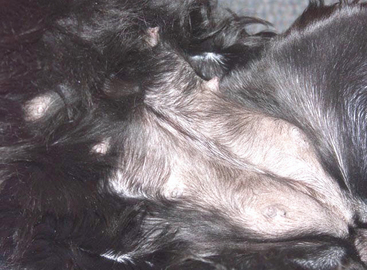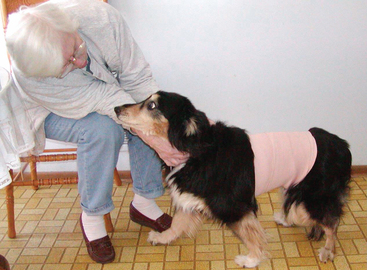18 Disorders of the Mammary Glands
No. The clinical signs of false pregnancy are due to a lack of progesterone. Removing the ovaries and uterus will not increase progesterone concentrations in the body. Spaying will, however, keep the bitch from ever having false pregnancy again because she will never go through heat again. Having a litter will not decrease signs of false pregnancy after subsequent heat cycles and may increase mammary development and milk production.
I. MASTITIS
Mastitis is inflammation and infection of the mammary glands. It may occur occasionally as a component of false pregnancy (see below) but most commonly occurs postpartum, during peak lactation (see Chapter 14).
III. FALSE PREGNANCY
A. DEVELOPMENT
After estrus, or standing heat, all dogs go through a 2-month-long diestrus during which concentrations of progesterone are high (see Chapter 8). At the end of diestrus, progesterone concentrations in blood fall rapidly and concentrations of prolactin begin to rise. The prolonged high progesterone stimulates mammary development and may loosen joints, allowing some dogs to develop apparent abdominal distension as their ribs “spring” apart more. The sudden fall in progesterone and rise in prolactin stimulate milk production and behaviors of whelping, such as nesting and protection of offspring. Although all dogs undergo these hormonal changes, not all bitches exhibit clinical signs. Some describe bitches undergoing hormonal changes with no associated clinical signs as having covert false pregnancy, whereas those exhibiting signs have overt false pregnancy.
C. HISTORY AND CLINICAL SIGNS
Some bitches show overt signs of false pregnancy when they are young and stop as they age, whereas others will not show signs of false pregnancy until they are older. It is reported that 87% of bitches show signs of false pregnancy two or more times in their life while intact. Most bitches presenting with overt false pregnancy had gone through proestrus and estrus 1 to 3 months before presentation. The occasional bitch has been spayed recently or has just completed progesterone therapy. History of behavioral changes seen may include nesting, protection of inanimate objects such as pillows and stuffed animals, and aggression. Changes in appetite may occur. The mammary glands often are distended, and serous fluid or normal-appearing milk can be expressed (Figure 18-1). Galactorrhea is the medical term for inappropriate milk production. If secondary mastitis is present, the mammary glands are enlarged, hot, and painful to the bitch. All else is normal.
E. TREATMENT
Dogs with mild clinical signs are best treated very conservatively. For most, no therapy is necessary and the signs will subside within 7 to 10 days. For dogs with extreme mammary distension that are uncomfortable, I have had good success wrapping the dog’s mammary area with an elastic bandage and cutting the food and water in half for about a day (Figure 18-2). This puts pressure on the mammary glands, which sends a signal to the brain to stop secretion of prolactin and subsequent milk production; protects the mammary glands from trauma; and dehydrates the dog a bit, which slows milk production. Do not milk out the engorged mammary glands. Continuous removal of milk from the glands signals the body to continue milk production.
< div class='tao-gold-member'>
Stay updated, free articles. Join our Telegram channel

Full access? Get Clinical Tree




